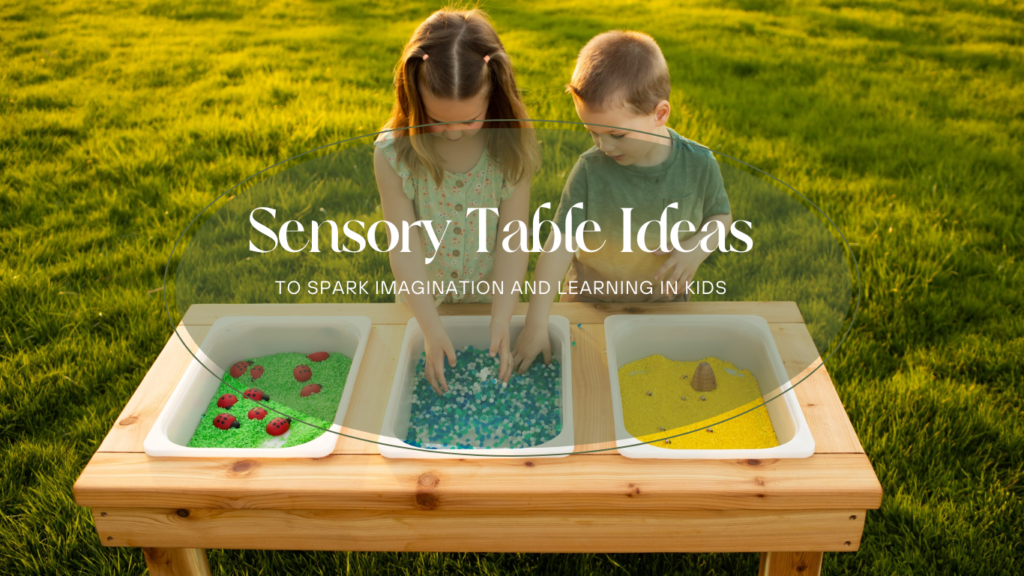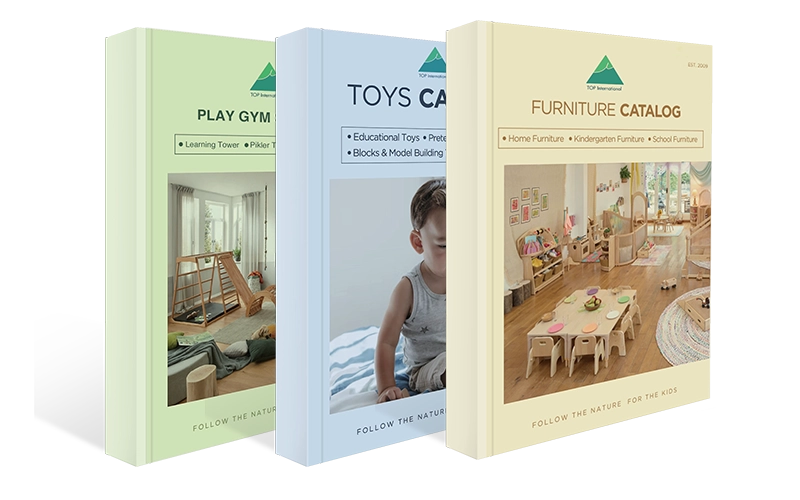Are you struggling to keep your preschoolers engaged and stimulated? Frustrated by the same old activities and looking for fresh, educational ideas? Worried that your classroom isn’t nurturing sensory development enough? Don’t worry — today, we’re diving deep into the world of sensory table ideas to reignite your classroom magic!
A sensory table is not just play—it’s how young children learn. Through touch, movement, and exploration, they develop المهارات الحركية الدقيقة, build brain connections, regulate emotions, and make sense of the world. This is why well-designed sensory table ideas are essential in any modern early learning environment. Whether you’re planning preschool sensory table ideas or toddler-friendly activities, the value goes far beyond entertainment.
In the sections below, I’ll walk you through 38 practical and creative sensory table ideas—each one designed to inspire hands-on learning, spark imagination, and meet the real needs of preschool classrooms.
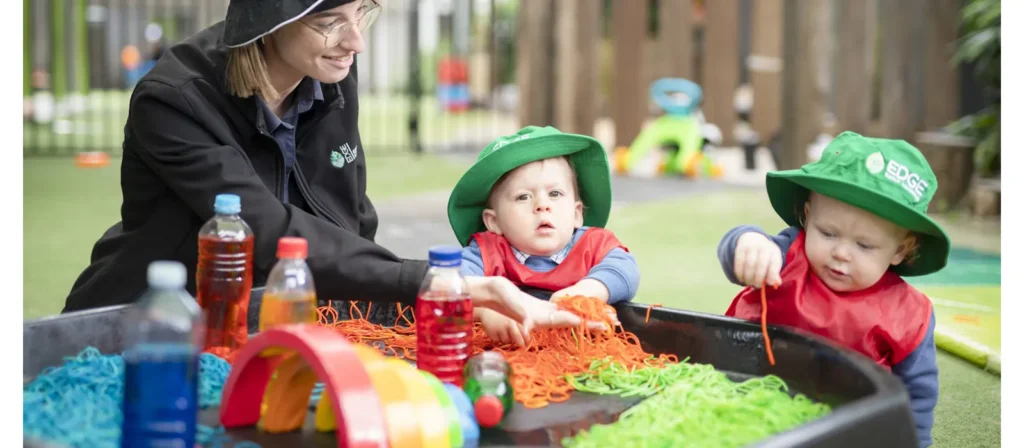
The Benefits of Using Sensory Tables in Preschool Classrooms
Sensory tables are far more than just activity stations—they are essential tools that support whole-child development in early education environments. From promoting brain development to fostering emotional intelligence and early literacy, well-designed sensory table ideas play a vital role in preparing children for more complex learning. The following benefits explain why sensory tables are a cornerstone of high-quality preschool classrooms.
Sensory Play Lays the Foundation for Learning
Sensory input is the first pathway to understanding. As Maria Montessori observed, “Nothing comes to the intellect that is not first in the senses.” Sensory tables engage children’s primary learning channels—touch, sight, sound, and movement—offering a developmentally appropriate gateway to deeper learning.
Enhances Brain Development Through Hands-On Exploration
When children scoop rice, pour water, or dig through sand, they activate and strengthen neural pathways. These activities support:
- Fine and gross motor skill development
- Cause-and-effect understanding
- Spatial awareness
- Curiosity-driven inquiry
Strengthens Social and Emotional Skills
Sensory play encourages children to interact, share materials, take turns, and communicate. It also offers opportunities for emotional regulation through focused, calming activities. In a shared sensory environment, children learn cooperation, empathy, and patience—essential skills for group learning settings.
Encourages Focus, Creativity, and Problem-Solving
Open-ended sensory materials promote experimentation and discovery. Children naturally engage in problem-solving as they test ideas, combine elements, and adapt their actions. Sensory tables foster sustained attention and creative thinking, both critical for future academic success.
Supports Language and Literacy Development
As children manipulate objects, they often describe what they’re doing, hear new vocabulary from peers and adults, and use descriptive language. These experiences contribute to vocabulary growth, comprehension skills, and expressive communication—all crucial in early literacy development.
Promotes Independent and Self-Directed Learning
Sensory tables invite choice and autonomy. Children select tools, materials, and actions, building confidence and decision-making abilities. The open-ended nature of sensory activities respects individual learning styles and promotes initiative.
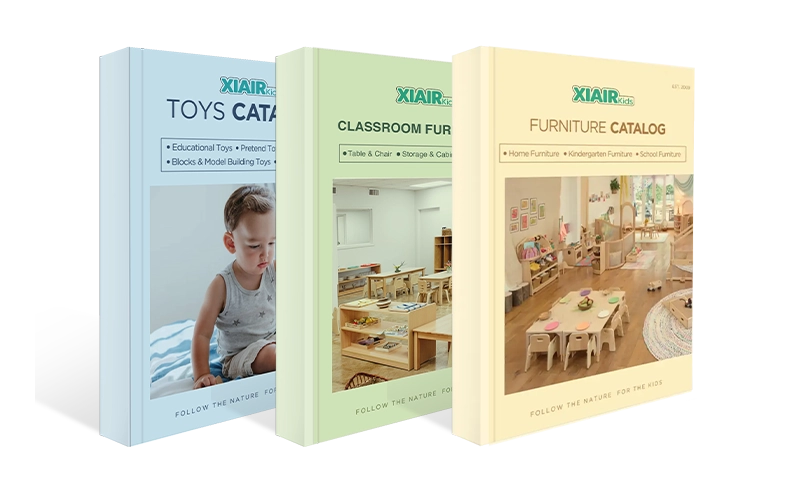
Receive a free catalog and custom layout to help you design your ideal classroom easily.
How to Set Up a Sensory Table
The effectiveness of any sensory activity begins with how the sensory table is prepared. A thoughtful and well-organized setup enhances safety, supports independent exploration, and maximizes the developmental benefits of sensory play. From choosing the right fillers to selecting age-appropriate tools, every detail contributes to how children engage, learn, and grow through hands-on experiences, whether applying new sensory table ideas or rotating seasonal themes. A proper setup ensures purposeful and impactful learning.
Step 1: Choose the Right Sensory Table
The right sensory table should be sturdy, safe, easy to clean, and appropriately sized for the age The right sensory table should be sturdy, safe, easy to clean, and appropriately sized for the age group. Features to look for include:
- Non-toxic, durable materials
- Rounded edges for safety
- Adjustable height for ergonomic use
- Open access from all sides
- Space to support a variety of sensory tools and materials
A high-quality sensory table provides the structure needed to support diverse sensory table ideas for preschoolers. At TOP Montessoris, we offer multiple models and configurations to meet different classroom needs, from compact single-basin tables to large multi-child setups—all designed with both safety and functionality in mind.

Step 2: Select a Sensory Theme or Material
Before setup, define the goal of the sensory activity. A clear theme brings direction and structure to your sensory table ideas and helps maintain student engagement.
Common sensory materials include:
- Dry fillers: rice, pasta, sand, beans
- Wet fillers: water, slime, shaving cream, gel beads
- Natural items: leaves, sticks, pinecones, shells
- Seasonal themes: snow (real or artificial), pumpkins, holiday-themed fillers
Linking themes to classroom curriculum or developmental goals makes activities more meaningful and adaptable across age groups. If you need more preschool materials or other student supplies, you can refer to this supply list for additional ideas and guidance.
Step 3: Prepare and Organize the Materials
Safe and organized materials create a more productive sensory experience. Consider the following during preparation:
- Pre-color rice or pasta with food-safe dye
- Cut large materials into safe, manageable sizes
- Avoid small objects for toddlers to minimize choking hazards
- Use trays or bins for sorting and containment
Thoughtful preparation enhances both the educational and practical outcomes of your preschool sensory table ideas.
Step 4: Set Up Tools and Accessories
Add appropriate tools based on your filler materials. These tools support skill development in motor control, coordination, and problem-solving. Examples include:
- Measuring cups and funnels
- Spoons and tweezers
- Shovels or small scoops
- Pouring containers or jars
Well-selected tools elevate basic sensory table ideas into more complex, skill-based experiences.
Step 5: Establish Clear Play Rules
Sensory play should take place within a structured environment. Clear guidelines not only promote safety but also build self-regulation and social skills. Common rules include:
- Keep all materials inside the table
- Use tools gently and responsibly
- Take turns and share space
- Wash your hands before and after use
Posting visual reminders can help reinforce behavior expectations, especially with sensory table ideas for toddlers and younger preschoolers.
Step 6: Supervise and Engage
Adult presence during sensory activities ensures safety and allows for learning opportunities to be maximized. Supervision involves:
- Observing for emotional cues or safety risks
- Asking guiding questions (“What do you feel?” “What happens when…?”)
- Supporting children who need assistance or redirection
Active engagement during play promotes language development and deepens the educational impact of your sensory table activities.
Step 7: Rotate Themes Regularly
To maintain attention and extend learning, rotate sensory table themes regularly—ideally weekly. Changing textures, colors, and concepts not only keeps interest high but also supports diverse areas of development.
Themes can be rotated based on:
- Seasonal changes (e.g., autumn sensory table ideas, winter sensory table ideas)
- Classroom topics or weekly units
- Children’s spontaneous interests or questions
With consistent updates, your sensory table becomes a dynamic, evolving center for creativity and exploration. Permanent hotspot for hands-on learning and exploration.
Dry Fillers Sensory Table Ideas
Dry fillers are among the most versatile and easy-to-manage sensory table ideas, ideal for promoting tactile exploration, fine motor development, and early math concepts such as scooping, measuring, and sorting. Commonly used in preschool and daycare environments, dry filler sensory table ideas support independent learning, encourage creativity, and provide structured yet playful experiences that stimulate children’s natural curiosity and problem-solving abilities.
1. Colored Rice Exploration
Fill your sensory table with vibrant, colored rice.
Children can run their fingers through the grains, scoop, pour, and even practice color sorting.
This classic choice is a cornerstone of effective preschool sensory table ideas.

المواد المطلوبة:
- Colored rice
- Scoops
- Cups
- Small containers
Educational focus: Fine motor skills, color recognition, and sensory processing.
2. Rainbow Pasta Dig
Dye different pasta shapes (elbows, shells, bowties) in a rainbow of colors.
Hide small objects or letters inside for children to find using tweezers or their hands.
Rainbow pasta offers a colorful, textural dimension to your sensory table ideas for preschool classrooms.

المواد المطلوبة:
- Colored pasta (elbows, shells, bowties)
- Tweezers
- Small hidden objects or letters
Educational focus: Fine motor control, matching, and early literacy.
3. Dried Beans and Scoop Play
Offer a variety of dried beans—kidney beans, black beans, pinto beans—and several scoops, cups, and small containers.
The different textures and sizes encourage sorting activities and volume exploration, making it a timeless sensory table idea.

المواد المطلوبة:
- Dried beans (kidney beans, black beans, pinto beans)
- Scoops
- Cups
- Small containers
Educational focus: Math concepts, sensory exploration, and problem-solving.
4. Corn Kernels and Mini Tractors
Fill the table with dried corn kernels and add miniature tractors, harvesters, and farm animals.
This farm-themed setup fits beautifully into seasonal or agriculture-inspired preschool sensory table ideas.

المواد المطلوبة:
- Dried corn kernels
- Miniature tractors
- Harvesters
- Farm animal figurines
Educational focus: Imaginative play, gross motor coordination, and agriculture awareness.
5. Sand and Hidden Treasure Hunt
Classic sandbox play never gets old.
Hide “treasures” like colorful gems, plastic coins, or tiny toys in the sand.
This sensory-rich activity remains a popular choice among outdoor sensory table ideas.

المواد المطلوبة:
- Play sand
- Colorful gems
- Plastic coins
- Small hidden toys
Educational focus: Discovery skills, tactile processing, and critical thinking.
6. Birdseed Sensory Play
Fill your sensory table with birdseed for a multi-textured experience.
Add small birds, nests, and scoops to inspire nature-themed sensory table ideas for preschoolers.

المواد المطلوبة:
- Birdseed
- Small bird figurines
- Nests
- Scoops
Educational focus: Nature exploration, hand strength development, and imaginative storytelling.
7. Coffee Beans and Measuring Cups
Fill the table with fragrant coffee beans and different-sized measuring cups and spoons.
The scent engages additional senses, making it a unique addition to your collection of sensory table ideas.
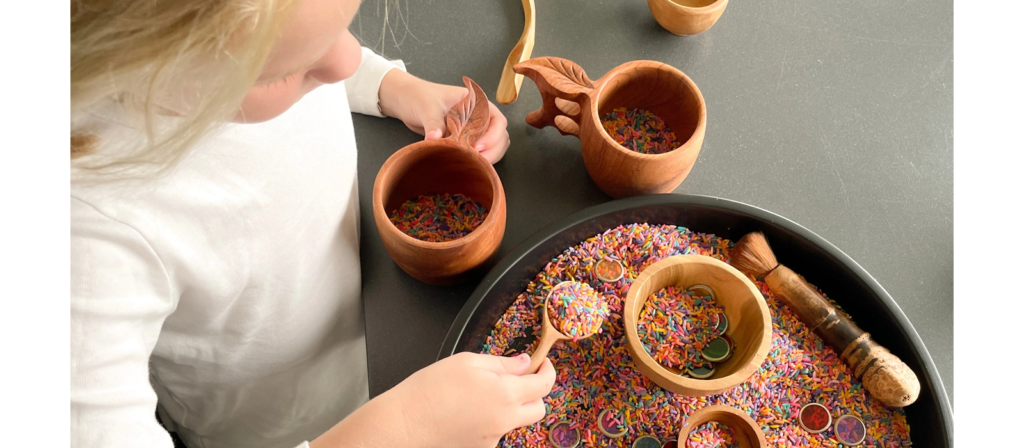
المواد المطلوبة:
- Coffee beans
- Measuring cups
- Measuring spoons
Educational focus: Sensory integration, measuring skills, and olfactory stimulation.
8. Shredded Paper Color Match
Use shredded colored paper and hide matching colored objects inside.
Children must dig through the paper to find and sort the items into color-coded bins, offering a playful way to implement color-based preschool sensory table ideas.

المواد المطلوبة:
- Colored shredded paper
- Small color-matching objects
- Color-coded bins
Educational focus: Color recognition, categorization, and tactile exploration.
9. Cereal Box PlayStation
Fill the table with crunchy cereals like Cheerios, Rice Krispies, or puffed rice.
Add scoops and funnels to encourage pouring and sensory processing.
This edible option makes a safe and engaging addition to your sensory table ideas for preschool toddlers.

المواد المطلوبة:
- Assorted cereals (Cheerios, Rice Krispies, puffed rice)
- Scoops
- Funnels
Educational focus: Fine motor skills, safe sensory play, and cause-and-effect learning.
10. Popcorn Kernels Sensory Bin
Plain, unpopped popcorn kernels offer a fun texture that’s less messy than sand.
Provide small cups, scoops, and funnels to foster exploration of movement and volume through these playful sensory table ideas.

المواد المطلوبة:
- Unpopped popcorn kernels
- Cups
- Scoops
- Funnels
Educational focus: Sensory development, coordination, and exploratory learning.
Wet Fillers Sensory Table Ideas
Wet fillers add a new level of sensory engagement, enriching sensory table ideas with opportunities for hands-on scientific discovery. They allow children to explore temperature, texture, viscosity, buoyancy, and cause-and-effect relationships in a highly interactive way. Sensory tables with waterproof and easy-to-clean surfaces are especially effective for supporting wet-based activities in preschool and daycare settings. Incorporating water, foam, slime, or gelatin into your preschool sensory table ideas not only keeps children engaged but also promotes cognitive development, coordination, and early STEM learning in a playful, safe environment.
11. Water Play with Floating Toys
Fill your sensory table with clean water and add floating toys like boats, rubber ducks, or sponges.
Children can observe what floats and what sinks, practicing basic science concepts while enjoying splashing fun — a simple yet effective example of dynamic sensory table ideas.
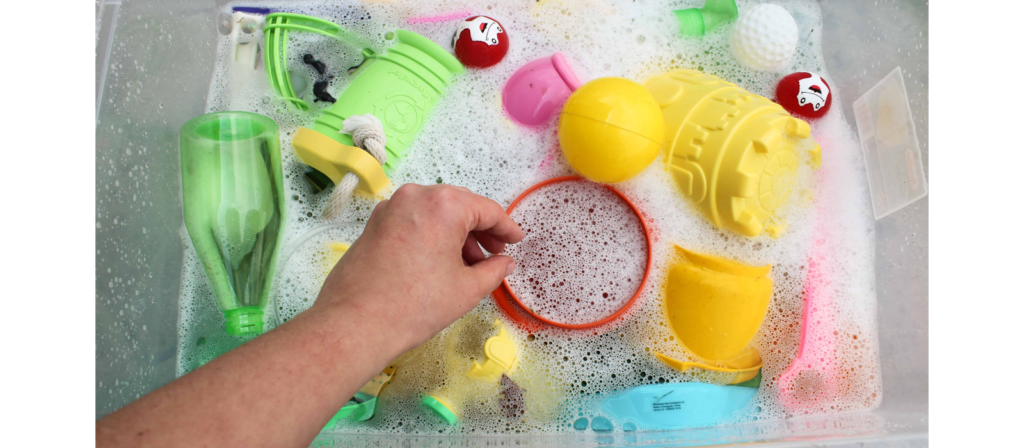
المواد المطلوبة:
- Clean water
- Floating toys (boats, rubber ducks, sponges)
Educational focus: Scientific thinking, water safety awareness, and motor skill refinement.
12. Ice Cube Excavation
Add colorful ice cubes or freeze small toys inside ice blocks for an exciting excavation challenge.
This is a favorite among preschool sensory table ideas, offering both fine motor development and hands-on science exploration.

المواد المطلوبة:
- Colorful ice cubes
- Small toys frozen inside ice
Educational focus: Cause and effect, problem-solving skills, and temperature awareness.
13. Water Beads Sensory Spa
Water beads offer a slippery, squishy texture that fascinates young learners.
Fill the table with hydrated water beads and provide small cups or ladles for transferring activities, enriching your collection of sensory table ideas for preschool environments.

المواد المطلوبة:
- Hydrated water beads
- Small cups
- Ladles
Educational focus: Tactile stimulation, hand-eye coordination, and sensory integration.
14. Mud Kitchen Simulation
Create a pretend “mud kitchen” by mixing soil and water right inside the sensory table.
Old pots, pans, and utensils turn this setup into one of the most creative preschool sensory table ideas for imaginative, hands-on play.

المواد المطلوبة:
- Soil
- ماء
- Old pots and pans
- Utensils
Educational focus: Creativity, fine motor development, and environmental awareness.
15. Gelatin Treasure Hunt
Prepare colorful gelatin blocks and embed small toys or objects inside.
Children can squish, cut, and dig through the gelatin to retrieve treasures, offering a unique variation among sensory table ideas.
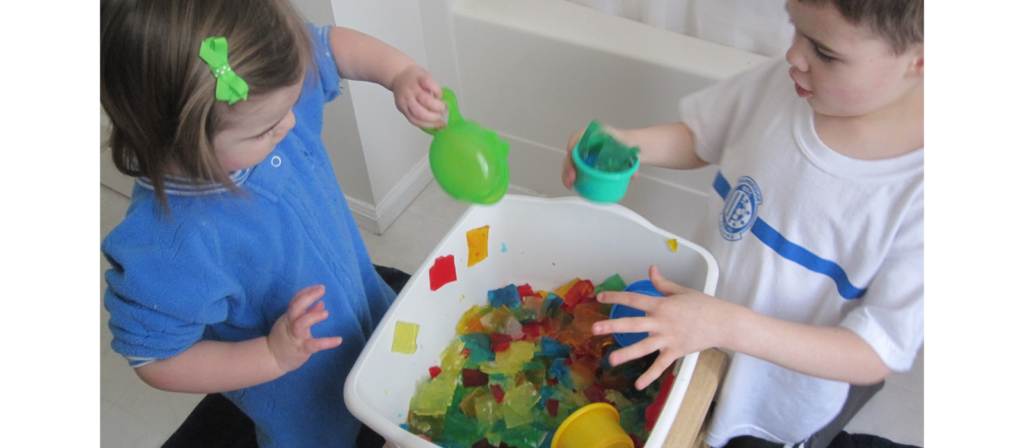
المواد المطلوبة:
- Colorful gelatin blocks
- Small embedded toys or objects
Educational focus: Sensory exploration, fine motor control, and early science observation.
16. Shaving Cream Fun
Fill the table with fluffy shaving cream and allow children to swirl, mix colors, and draw shapes.
Adding paintbrushes, combs, or toy vehicles makes this one of the most expressive sensory table ideas for preschool play.

المواد المطلوبة:
- كريم الحلاقة
- فرش الرسم
- Combs
- Toy vehicles
Educational focus: Art exploration, sensory processing, and emotional expression.
17. Bubbles and Boats
Mix a generous amount of bubble solution with water to create a foamy sensory experience.
Float lightweight toys through the bubbles to combine science and fun — a creative twist on traditional preschool sensory table ideas.
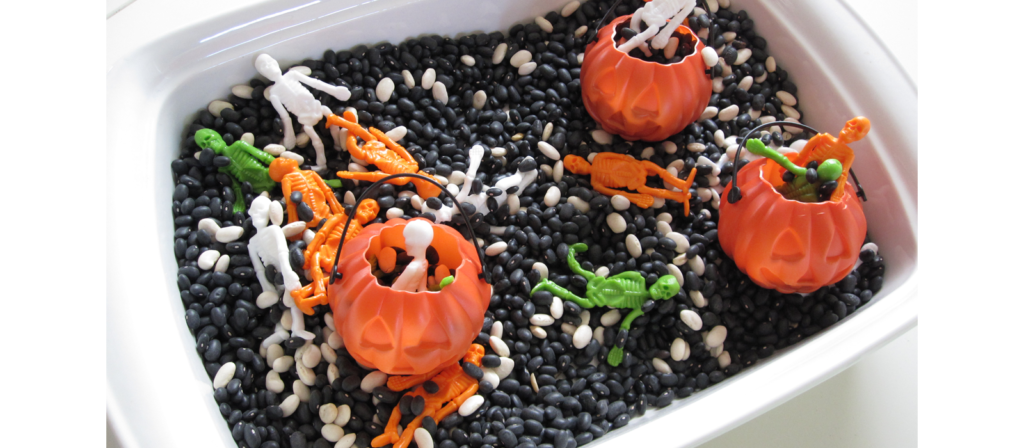
المواد المطلوبة:
- Bubble solution
- Clean water
- Floating lightweight toys
Educational focus: Scientific observation, sensory stimulation, and motor coordination.
18. Snow Sensory Table (Real or Artificial)
If you have access to real snow, bring it into the classroom for a thrilling sensory experience.
Artificial snow works beautifully as well, offering winter-themed sensory table ideas that spark imaginative storytelling.
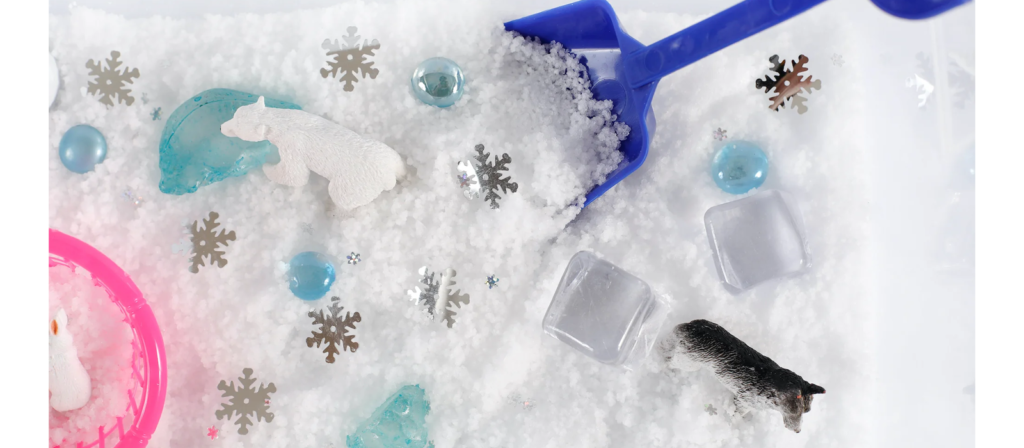
المواد المطلوبة:
- Real snow or artificial snow
- Winter-themed toys (optional)
Educational focus: Seasonal awareness, temperature sensory exploration, and imaginative storytelling.
19. Slime Table (with Supervision!)
Prepare safe, non-toxic homemade slime and allow children to stretch, pull, and manipulate the substance.
While extra supervision is necessary, slime-based activities remain among the most exciting sensory table ideas for preschoolers.

المواد المطلوبة:
- Non-toxic homemade slime
Educational focus: Texture exploration, creativity, and fine motor strengthening.
20. Colored Water Pouring Station
Dye water with food coloring and set out measuring cups, droppers, funnels, and minor pitchers.
This vibrant setup helps children experiment with mixing and transferring liquids — a colorful highlight in your repertoire of sensory table ideas.

المواد المطلوبة:
- ماء
- Food coloring
- Measuring cups
- Droppers
- Funnels
- Small pitchers
Educational focus: Color theory, cause and effect, and precision pouring skills.
Nature-Based Sensory Table Ideas
Incorporating natural elements into sensory table ideas brings children closer to the environment in meaningful ways. Nature-based fillers are a perfect fit for Montessori and Reggio Emilia-inspired classrooms, offering some of the most enriching sensory table ideas for preschool education. These setups help children observe, explore, and connect with the world around them.
Here are some of our favorite nature-based preschool sensory table ideas:
21. Fall Leaves Collection
Gather a variety of colorful autumn leaves and scatter them across the sensory table.
Add magnifying glasses so children can examine the veins, textures, and color variations of the leaves, blending seasonal learning with timeless sensory table ideas.

المواد المطلوبة:
- Colorful fall leaves
- Magnifying glasses
Educational focus: Nature appreciation, observation skills, and color differentiation.
22. Pinecones and Cinnamon Sticks
Combine pinecones, cinnamon sticks, and a few sprigs of evergreen for a rich, multi-sensory experience.
This setup is especially popular among holiday-themed preschool sensory table ideas, offering touch and smell exploration.

المواد المطلوبة:
- مخاريط الصنوبر
- أعواد القرفة
- Evergreen sprigs
Educational focus: Sensory stimulation, holiday-themed exploration, and construction play.
23. Sand and Seashells
Bring the beach into your classroom!
Fill the sensory table with clean sand and a collection of seashells, coral pieces, and small scoops.
This is a classic in nature-based sensory table ideas for preschoolers, promoting natural classification and sensory discovery.

المواد المطلوبة:
- Play sand
- Seashells
- Coral pieces
- Small scoops
Educational focus: Natural classification, tactile processing, and marine science introduction.
24. Pebbles and Driftwood
Use smooth river pebbles, pieces of driftwood, and small sticks to create a nature construction zone.
Children can stack, balance, and design miniature landscapes, adding a creative engineering twist to traditional sensory table ideas.

المواد المطلوبة:
- Smooth river pebbles
- Pieces of driftwood
- Small sticks
Educational focus: Engineering concepts, balance and stability, and creative design.
25. Flower Petal Sensory Bin
Fill the sensory table with freshly picked or artificial flower petals.
Add tweezers and magnifying glasses to encourage detailed observation and careful handling, enhancing the sophistication of your preschool sensory table ideas.
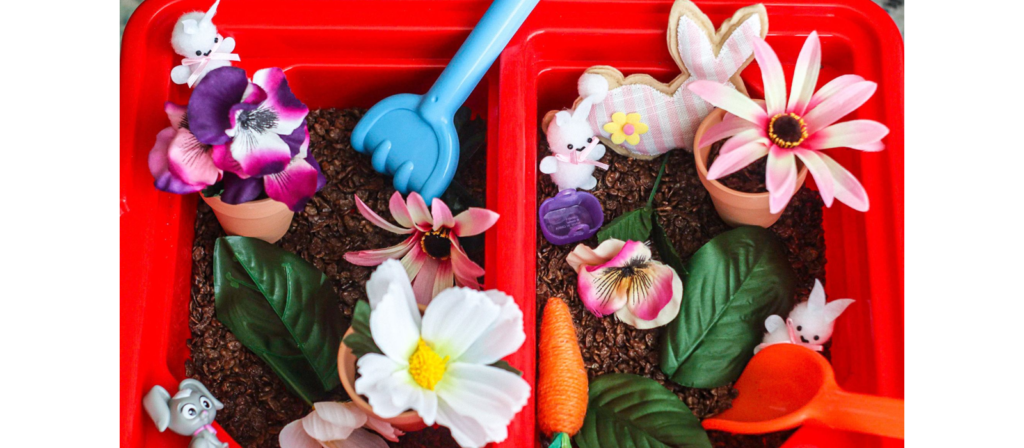
المواد المطلوبة:
- Fresh or artificial flower petals
- Tweezers
- Magnifying glasses
Educational focus: Botanical exploration, fine motor precision, and aesthetic appreciation.
26. Grass Patch Table
Line the sensory table with sod or artificial grass patches.
Add toy insects, small animals, and miniature fences to create an interactive nature-themed playground, perfect for dynamic sensory table ideas for preschool children.

المواد المطلوبة:
- Real sod or artificial grass
- Toy insects
- Small animals
- Miniature fences
Educational focus: Environmental awareness, habitat exploration, and imaginative play.
27. Dirt and Worm Hunt (Fake Worms!)
Create a “garden bed” by filling the table with soil and hiding rubber worms or bugs inside.
Provide small shovels and tweezers so children can dig, discover, and enjoy earth science-themed sensory table ideas.
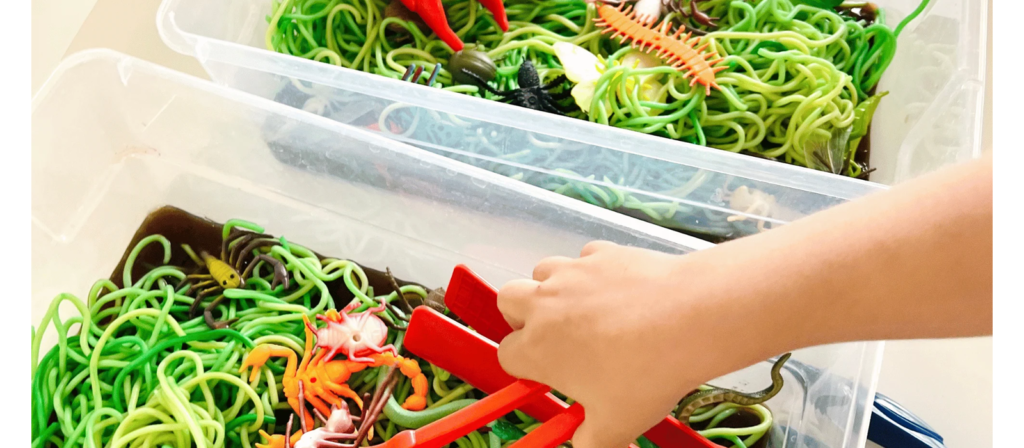
المواد المطلوبة:
- Soil
- Rubber worms or bugs
- Small shovels
- Tweezers
Educational focus: Earth science introduction, discovery learning, and tactile stimulation.
Theme-Based, Seasonal, and Holiday Sensory Table Ideas
Themed sensory table setups bring fresh excitement and deeper learning to the classroom.
By aligning sensory table ideas with popular topics, seasons, and holidays, educators can transform ordinary playtime into meaningful, memorable experiences. Here’s a complete collection of inspiring preschool sensory table ideas based on themes, seasons, and holidays:
28. Dinosaur Dig Site
Fill the sensory table with kinetic sand or coffee grounds to mimic dirt.
Bury small plastic dinosaurs and fossils. Provide brushes and small excavation tools for prehistoric treasure hunts — a classic in educational sensory table ideas.

المواد المطلوبة:
- Kinetic sand or coffee grounds
- Small plastic dinosaurs
- Fossils
- Brushes
- Small excavation tools
Educational focus: History awareness, fine motor skills, and scientific discovery.
29. Construction Zone
Add gravel, sand, and miniature construction vehicles like dump trucks and excavators.
Create mini “building sites” where children can scoop, transport, and build — a top pick among hands-on preschool sensory table ideas.
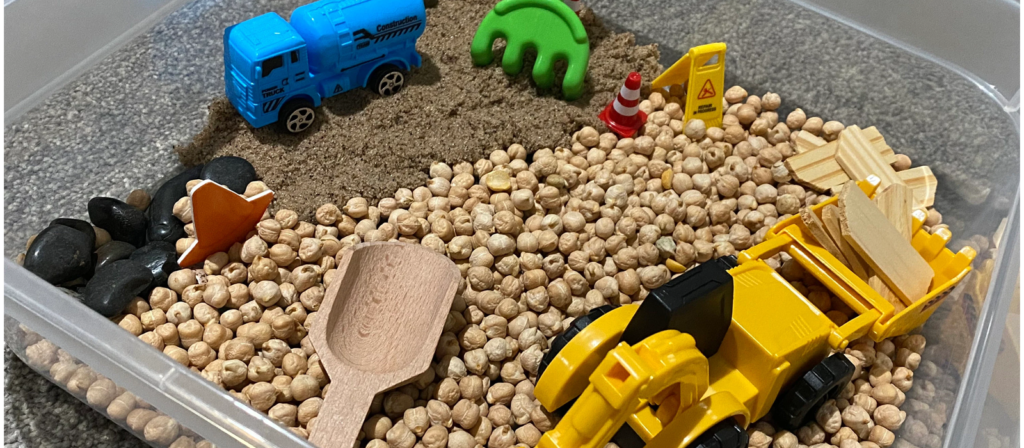
المواد المطلوبة:
- Gravel
- Sand
- Miniature construction vehicles (dump trucks, excavators)
Educational focus: Engineering thinking, cause and effect, and collaborative play.
30. Under-the-Sea Adventure
Fill the sensory table with blue-dyed water, toy fish, shells, and seaweed-like ribbons.
This underwater world supports imaginative storytelling and sensory immersion, making it a favorite among ocean-themed sensory table ideas.

المواد المطلوبة:
- Blue-dyed water
- Toy fish
- Shells
- Seaweed-like ribbons
Educational focus: Marine science, sensory immersion, and language development.
31. Arctic Ice Sensory Table
Use crushed ice or frozen water blocks to recreate an arctic landscape.
Add toy polar bears, penguins, and snowy accessories to spark cold-climate explorations — perfect for winter sensory table ideas for preschool classrooms.

المواد المطلوبة:
- Crushed ice or frozen water blocks
- Toy polar bears
- Penguins
- Snowy accessories
Educational focus: Environmental awareness, cold climate exploration, and tactile experience.
32. Space Station Setup
Create a cosmic adventure using black beans or dark-colored rice as the “space ground.”
Add astronauts, planets, stars, and spaceships for a journey into space-themed preschool sensory table ideas.

المواد المطلوبة:
- Black beans or dark-colored rice
- Toy astronauts
- Planet models
- Stars
- Spaceships
Educational focus: Astronomy basics, imagination, and spatial awareness.
33. Bakery Sensory Table with Flour
Spread flour across the sensory table to simulate a bakery workstation.
Provide rolling pins, cookie cutters, and measuring spoons to encourage pretend baking — a charming twist on everyday sensory table ideas.
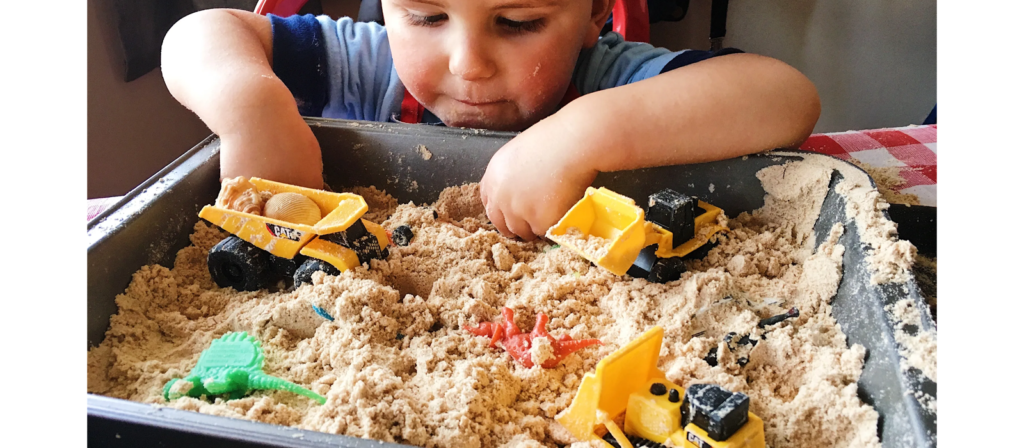
المواد المطلوبة:
- Flour
- Rolling pins
- Cookie cutters
- Measuring spoons
Educational focus: Practical life skills, sensory processing, and creative role-play.
34. Farm Animal Sensory Bin
Fill the table with hay (or shredded paper) and small farm animal figurines.
Children can create farm scenes, practice animal care, and role-play life on a farm — a foundational example of nurturing-based sensory table ideas for preschoolers.
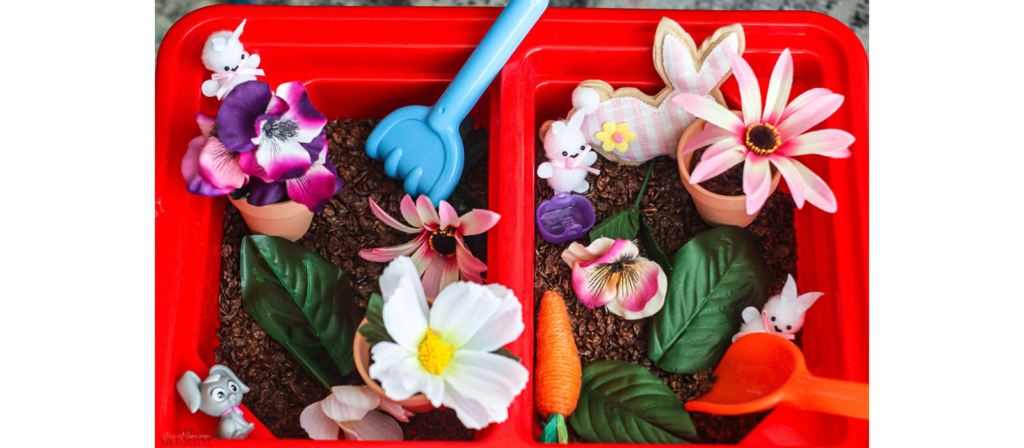
المواد المطلوبة:
- Hay or shredded paper
- Farm animal figurines
Educational focus: Agriculture awareness, nurturing empathy, and vocabulary building.
35. Autumn Harvest Table
Fill the sensory table with dried corn, small pumpkins, gourds, and fall leaves.
This harvest-themed setup is one of the coziest sensory table ideas for preschool, helping children engage with the textures and colors of fall.
المواد المطلوبة:
- Dried corn
- Small pumpkins
- Gourds
- Fall leaves
Educational focus: Seasonal changes, sensory variety, and counting skills.
36. Winter Wonderland Sensory Bin
Create a snowy sensory landscape with cotton balls, silver tinsel, and white rice.
Add snowflake cutouts and miniature snowmen for magical winter play — a festive highlight among seasonal preschool sensory table ideas.
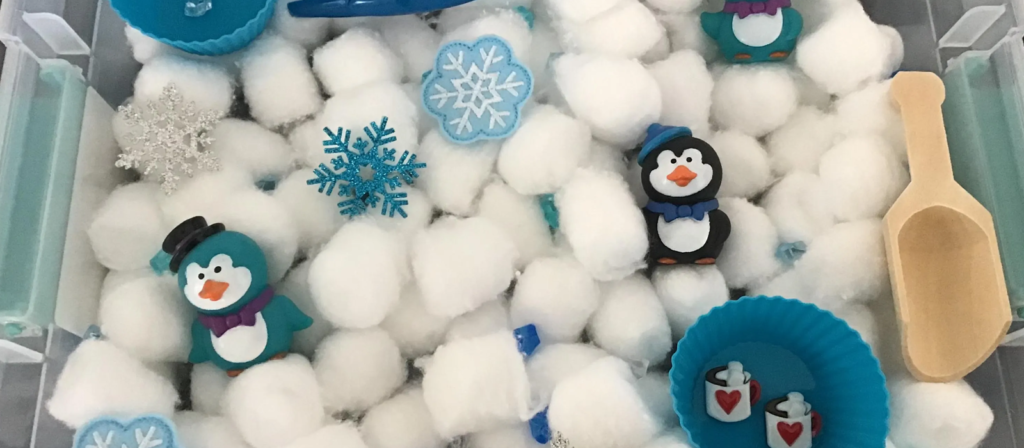
المواد المطلوبة:
- كرات القطن
- Silver tinsel
- White rice
- Snowflake cutouts
- Miniature snowmen
Educational focus: Seasonal literacy, tactile engagement, and creativity.
37. Spring Garden Sensory Table
Use artificial grass, silk flowers, and toy insects to create a spring garden theme.
Children can “plant,” “garden,” and explore nature, beautifully blending environmental awareness into their sensory table ideas.
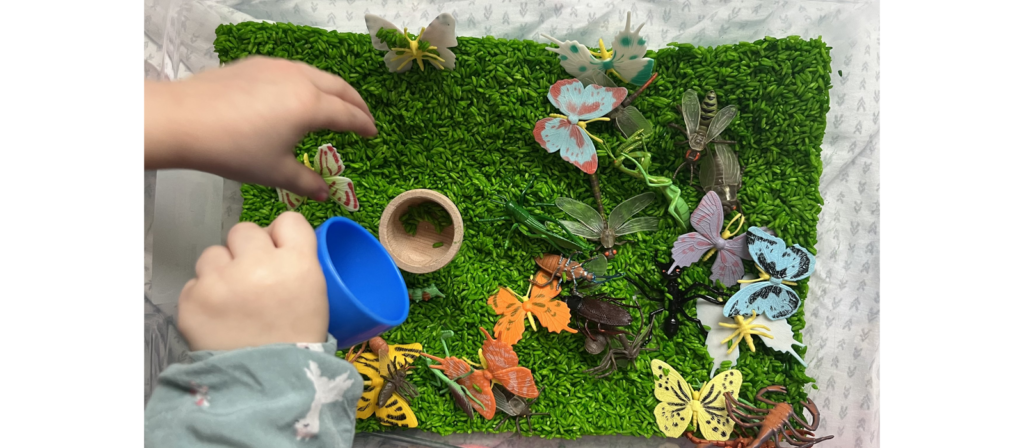
المواد المطلوبة:
- Artificial grass
- Silk flowers
- Toy insects
Educational focus: Plant life cycles, environmental stewardship, and imaginative exploration.
38. Summer Beach Day
Set up kinetic sand, seashells, water trays, and small beach toys.
Building sandcastles and simulating ocean play turns summer-themed sensory table ideas into immersive, memorable experiences.
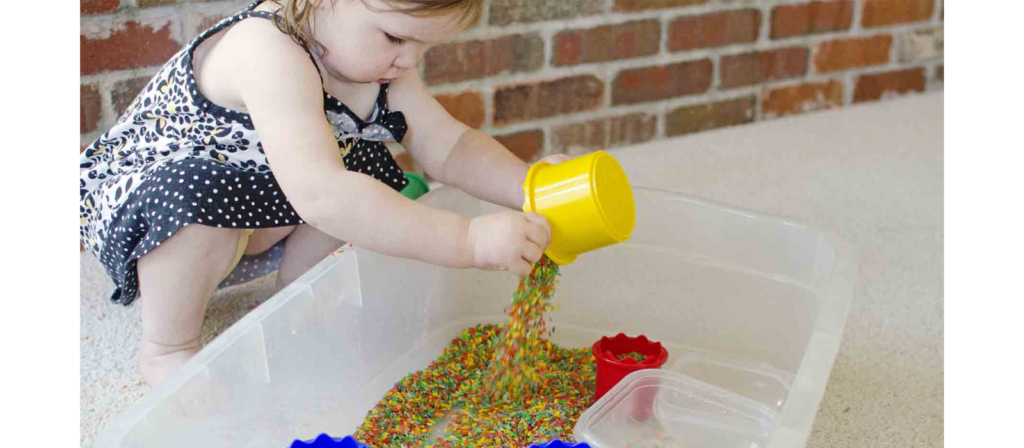
المواد المطلوبة:
- Artificial grass
- Silk flowers
- Toy insects
Educational focus: Seasonal understanding, sensory discovery, and fine motor development.

Receive a free catalog and custom layout to help you design your ideal classroom easily.
Types of Sensory Tables
Choosing the right sensory table depends on classroom needs, available space, and the type of sensory play activities you plan to implement. Below are several popular models designed for different educational settings and learning objectives.
Clear-View Sand and Water Tray Table
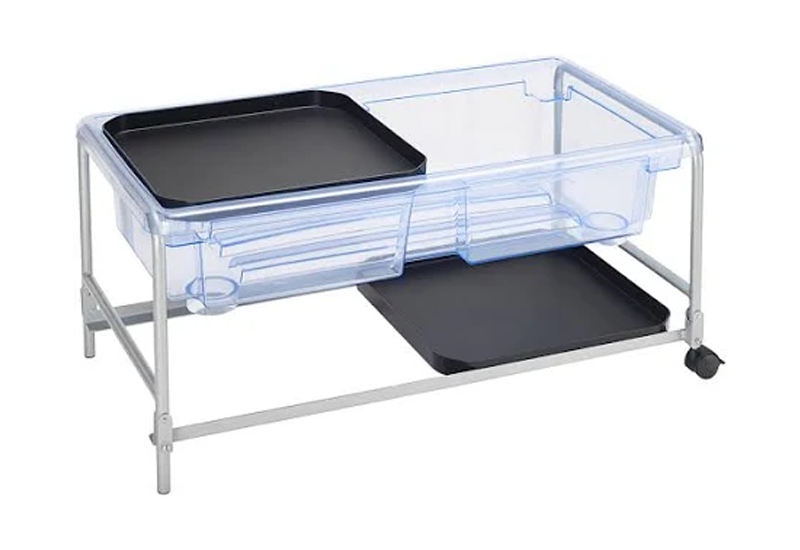
A transparent design that allows children and educators to see the materials inside from all angles—great for both group observation and self-guided play.
المزايا:
- Transparent walls promote visual engagement and observation
- Lightweight and ideal for mobile use or learning centers
- Suitable for both wet and dry fillers
Mobile Sand & Water Table with Top
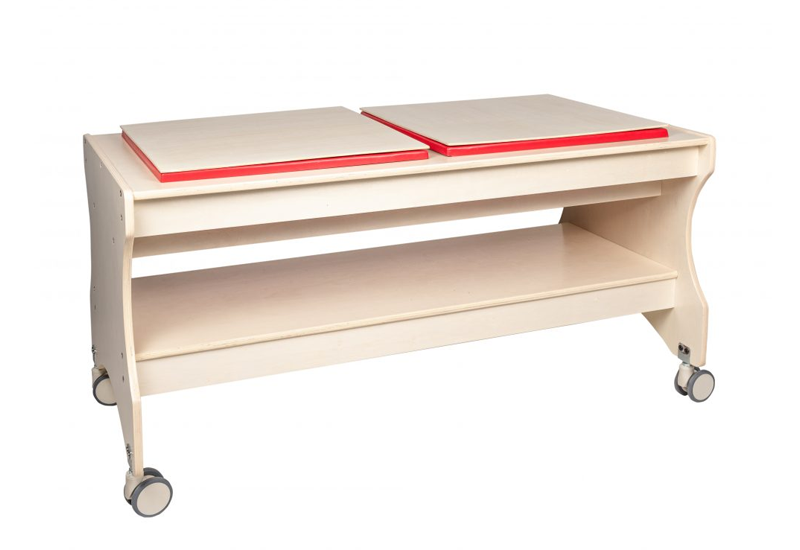
This versatile table includes a removable top cover, making it easy to convert from a sensory station to a work surface.
المزايا:
- Locking wheels allow for easy relocation
- Lid provides a clean surface when not in use
- Deep basin suitable for high-volume filler play
Mobile Sensory Play Kitchen

A hybrid sensory and pretend play station, ideal for Montessori and Reggio Emilia-inspired environments.
المزايا:
- Combines water play with role-playing activities
- Built-in sinks, compartments, and knobs for imaginative use
- Wheels for easy classroom reconfiguration
Mobile Sensory Table with Trays & Lids

This functional table features multiple trays and individual lids, supporting simultaneous small-group exploration.
المزايا:
- Tray-based system allows for quick theme changes
- Lids help with safe storage between uses
- Encourages independent, compartmentalized play
Mud Kitchen and Outdoor Exploration Center

A robust, weather-resistant unit designed for outdoor, nature-based sensory play and real-world exploration.
المزايا:
- Built with outdoor-grade materials for year-round use
- Integrated storage and hooks for garden tools and accessories
- Encourages hands-on STEM learning and messy play
Sand & Water Table for Outdoor Learning Environments

Durable and designed to withstand outdoor conditions, this table is great for schools with nature-based programs or playgrounds.
المزايا:
- UV-resistant surfaces and rust-proof frames
- Large basin supports collaborative group play
- Easy to drain and clean after use
Sand and Water Clam-Shaped Sensory Table

With its engaging clam-shell design, this table offers a unique aesthetic and functional advantage for theme-based classrooms.
المزايا:
- Fun, child-friendly shape captures interest
- Dual-basin structure supports two types of fillers
- Durable plastic construction for indoor or outdoor use
Where to Buy Sensory Tables
Explore trusted suppliers offering high-quality sensory tables suitable for early childhood education settings. Below are some recommended sources and what they offer:
TOP Montessoris – One-Stop B2B Preschool Supplies Factory
With over 20 years of industry experience, TOP Montessoris specializes in designing and manufacturing durable, child-safe furniture and Montessori-inspired classroom materials. The factory offers complete customization, quick prototyping, and global shipping services. Their sensory tables are designed to support interactive, developmentally appropriate play in both indoor and outdoor settings.
Visit TOP Montessoris

Receive a free catalog and custom layout to help you design your ideal classroom easily.
Xiha Montessoris – Global Supplier for Montessori and Reggio Materials
Xiha Montessoris offers a curated selection of educational furniture, sensory tables, and toys tailored for international preschool programs. The platform is ideal for schools seeking Reggio Emilia and Montessori-compatible materials, with multilingual support and international logistics. Products are factory-direct with CE/CPC certifications for export.
Visit Xiha Montessoris
Westshore Furniture – Outdoor and Nature-Based Play Equipment Expert
A specialized factory brand under Dalian Westshore Wood, Westshore Furniture focuses on high-quality wooden preschool furniture and outdoor sensory play equipment. Their mud kitchens and weather-resistant sensory tables are ideal for nature-based programs and forest schools. Customization and OEM services available.
Visit Westshore Furniture
IKEA – Affordable Options for Home Daycare and Small Centers
IKEA offers a limited but reliable range of sensory play furniture suitable for casual or home-based early learning. Their products are easy to assemble, visually appealing, and budget-friendly—perfect for small-scale learning setups or supplementary classroom corners.
Visit IKEA
How to Reduce Sensory Table Mess
Managing mess is one of the most common concerns when implementing sensory table ideas for preschoolers and toddlers. Minimizing clean-up time while maintaining rich learning experiences is key to effective classroom management. The following strategies offer practical ways to reduce sensory table mess without limiting exploration or creativity, allowing educators to confidently integrate hands-on activities that support developmental goals in early childhood settings.
Choose Low-Mess Sensory Fillers
When planning preschool sensory table ideas, opt for fillers that are easy to contain and clean up.
Some of the best low-mess options include:
- Colored rice
- Dry pasta
- Birdseed
- Kinetic sand
- Large dried beans
Avoid excellent materials like glitter or tiny beads unless you are specifically preparing non-messy sensory table ideas with strict supervision.
Use a Sensory Mat or Floor Covering
Invest in a waterproof mat or large tray under the sensory table.
It catches stray materials and makes sweeping up a breeze.
For classrooms implementing diy sensory table ideas, an inexpensive shower curtain liner or tarp works perfectly as a catch surface.
Limit the Number of Children at the Table
One of the easiest ways to maintain order is by controlling the group size.
Limiting access to 2-4 children at a time, especially during sensory table ideas for toddlers, dramatically reduces spills and overcrowding.
Set up visual “wait your turn” signs or designated time slots if needed.
Teach Sensory Table Rules
Before engaging in any sensory play table ideas, it’s important to set ground rules:
- Keep materials inside the table
- Use scooping tools instead of throwing
- Walk, don’t run, near the table
- Help clean up spills immediately
Visual aids and repeated modeling help reinforce expectations, especially with sensory table ideas for 2-year-olds.
Set Up Child-Friendly Cleaning Stations
Incorporate small brooms, handheld vacuums, or dustpans near your sensory area.
When children participate in the cleanup, they develop responsibility and practical life skills, core values in the Montessori education model.

This approach works particularly well with diy sensory table ideas and encourages independent learning behaviors.
Rotate Sensory Activities Thoughtfully
Alternate between low-mess and high-mess sensory table ideas during the week.
على سبيل المثال:
- Monday: Rice pouring station (easy clean-up)
- Wednesday: Bubble foam play (more supervision needed)
- Friday: Nature-based filler (like leaves or pebbles)
Planning allows your classroom to enjoy diverse sensory experiences while keeping the mess under control.
Choose Our Sensory Tables for Your Classroom
One of the biggest challenges with sensory play is managing mess, especially in busy preschool environments where time, space, and supervision are limited. At TOP Montessoris, we design our sensory tables specifically to address this issue. Every feature is engineered to reduce spillage, simplify cleaning, and support organized play, without limiting the creativity of sensory table ideas for toddlers and preschoolers.
Key mess-reducing features of our sensory tables include:
- Smooth, waterproof surfaces that resist staining and are easy to wipe down after wet or messy activities
- Removable trays that allow fast filler changes and thorough sanitization between uses
- Rounded corners and seamless joints that prevent debris buildup and reduce cleaning time
- Optional lids and storage compartments for keeping tools and fillers tidy when not in use

By combining these thoughtful design elements, our sensory tables make it easier for educators to rotate activities, maintain hygiene, and implement sensory table ideas without worrying about excessive cleanup or disruption. They’re built not only for learning, but for real classroom efficiency.
Important Safety Information
Safety is a critical consideration when implementing sensory table ideas for preschool and toddler settings. From selecting age-appropriate materials to ensuring proper supervision and table design, each element must align with early childhood safety standards. Creating a safe sensory environment not only protects children physically but also promotes confident, independent exploration. The following guidelines outline key areas to address in order to ensure that sensory play remains both enriching and secure.
Choose Age-Appropriate Materials
When planning sensory table ideas for toddlers and preschoolers, always select fillers and tools that are appropriate for their developmental stage.
Avoid small objects like beads, tiny buttons, or seeds that can present choking hazards, especially for children under 3 years old.
Best practices:
- Use larger, easy-to-handle fillers like big pasta, foam blocks, or textured fabrics.
- For sensory table ideas for 1-year-olds and infants, stick with soft, edible, or oversized materials.
Ensure Table and Equipment Safety
All sensory tables used in preschool and daycare settings should meet strict safety standards. High-quality equipment should be made from non-toxic, child-safe materials, with smooth, rounded edges to prevent injuries and sturdy frames that resist tipping. Waterproof, easy-to-sanitize surfaces are essential for maintaining hygiene, especially when rotating between wet and dry sensory table ideas. Reliable, well-designed furniture supports both safe sensory play and the long-term efficiency of classroom operations.
Maintain Constant Supervision
Never leave children unattended at the sensory table, even for simple diy sensory table ideas like water play or dry rice pouring.
Adult supervision helps prevent:
- Choking risks
- Material ingestion
- Rough behavior that could cause accidents
Supervisors should also encourage proper handling of materials and reinforce classroom rules during play.

Sanitize Sensory Materials Regularly
Health and safety are just as important as physical safety.
Sensory table fillers can harbor bacteria, especially when using wet materials like water, shaving cream, or gelatin.
Recommendations:
- Change wet fillers daily
- Disinfect dry fillers weekly or after heavy use
- Clean the sensory table surface after every session
This practice is especially critical when rotating between different sensory table ideas for preschoolers throughout the week.
Be Aware of Allergies and Sensitivities
Always verify that none of the sensory table materials could trigger allergic reactions in your students.
Common allergens to watch for include:
- Nuts (even in sensory fillers)
- Gluten (in pasta-based activities)
- Latex (in some balloons or toys)
Communicating with parents about upcoming kindergarten sensory table ideas involving food or nature items helps prevent emergencies.
الأسئلة الشائعة
What is a sensory table for preschoolers?
A sensory table is a specially designed piece of furniture where young children can explore different textures, materials, and activities safely.
It’s an essential tool in early childhood education, perfect for implementing a variety of sensory table ideas for preschool classrooms, from water play to sand exploration.
What are good sensory activities for preschoolers?
Great sensory activities include water pouring, rice scooping, mud kitchens, and nature hunts.
Popular seasonal setups like fall sensory table ideas, winter sensory table ideas, and spring sensory table ideas keep preschoolers engaged year-round.
What type of object would be appropriate in a sensory table?
Safe and stimulating objects include:
- Dried beans
- Colored rice
- Water beads
- Foam blocks
- Natural materials like leaves and pebbles
Choosing the right sensory table filler ideas is crucial, especially when setting up sensory table ideas for toddlers or younger preschoolers.
Which is an unsafe ingredient to avoid in sensory activities for children?
Unsafe ingredients include minor choking hazards (e.g., tiny beads), allergens (like nuts), and non-edible or toxic materials.
When planning diy sensory table ideas or sensory table ideas for 2-year-olds, always verify that all fillers are large, non-toxic, and allergy-safe.
What age is best for a sensory table?
Sensory tables can be introduced as early as 12 months, but the materials must be age-appropriate.
Sensory table ideas for 1-year-olds focus on safe, edible, and soft textures, while sensory table ideas for preschoolers offer more complex activities like themed sensory setups.
What is Montessori sensory play?
Montessori sensory play emphasizes hands-on learning through natural exploration.
It’s about providing open-ended materials that encourage discovery and independence, just like many of our Montessori sensory table ideas involving nature, water, and textures.
What are sensory toy examples?
Examples include textured balls, musical shakers, stacking blocks, water beads, and scented playdough.
Many of these are incorporated into ideas for a sensory table to promote multi-sensory development across touch, sight, sound, and smell.
What is the difference between a sensory table and a sensory bin?
A sensory table is a whole piece of child-sized furniture designed for group exploration.
A sensory bin is a portable container filled with sensory materials for individual or small group use.
Whether you use bins or tables, the key is applying creative sensory table ideas preschool children will love, like transportation sensory table ideas or outdoor sensory table ideas.
خاتمة
Sensory table ideas play a vital role in shaping engaging, developmentally appropriate learning environments for preschoolers. By incorporating dry, wet, nature-inspired, and themed sensory fillers, educators can promote exploration, critical thinking, and hands-on learning. These activities aren’t just about fun—they support foundational concepts in play-based learning, including fine motor skills, early literacy, problem-solving, and emotional regulation.
A well-structured play-based learning environment depends not only on the activities but also on the design of the space. Sensory play demands safe, accessible, and adaptable furniture that aligns with the principles of play-based learning, offering open-ended materials, child-height access, and durable finishes. The physical setup is integral to encouraging independence, collaboration, and deep engagement.
In settings where the importance of play-based learning is understood, high-quality furniture becomes more than a backdrop—it is part of the pedagogy itself. That’s why many early childhood centers turn to trusted providers who specialize in functional, child-centered design. With extensive experience in manufacturing preschool furniture tailored to sensory and educational needs, أفضل مدارس مونتيسوري offers thoughtfully crafted sensory tables that support not just play but purposeful, high-impact learning every day.

